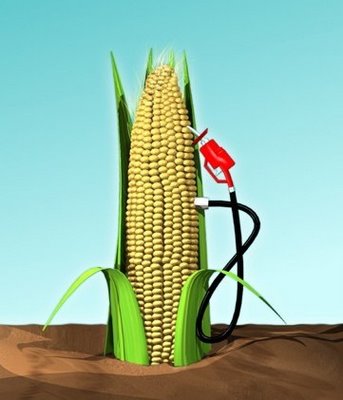Henry Miller at the Hoover Institution had a great piece in the Guardian yesterday–“The Great Fuel Fail.”
Rather than just simply stating that the production of ethanol for fuel is an unwise subsidy to special interests, Henry puts some perspective on the ethanol mania.
Although corn is a renewable resource, it has a far lower energy yield relative to the energy used to produce it – what policy wonks call “net energy balance” – than either biodiesel (such as soybean oil) or ethanol from many other plants. Moreover, ethanol production, particularly from corn, is a thirsty process, consuming roughly four gallons of water to produce each gallon of fuel. And when you count the water actually required to grow the corn, one gallon of ethanol “costs” a whopping 1,700 gallons of water. Finally, ethanol yields about 30% less energy per gallon than petrol, so mileage per gallon in internal combustion engines drops off significantly. And adding ethanol raises the price of blended fuel because it is more expensive to transport and handle.
He also points out that lower-cost biomass ethanol would make more economic sense, but large volumes of ethanol from biomass will not be commercially viable for years (and production will be delayed by subsidies encouraging the corn-based verison).
Alison Berry exlpored the costs and benefits of biomass in PERC Reports:
Although production of biomass ethanol is meager compared to corn-based ethanol, there are advantages to creating ethanol from biomass rather than corn. Cellulosic ethanol does not interfere with food production or require intensive agriculture. Raw materials—including not only wood, but grasses, yard trimmings, and even municipal waste—are abundant and cheap. As a renewable fuel source that is produced domestically and is carbon-neutral, biomass is an attractive alternative to fossil fuels. Yet economical production has proven elusive. In fact, commercialization has been “about five years away” for decades. Scientists continue to dispute the best technique for converting biomass to ethanol and, to date, there are no commercial-scale cellulosic ethanol refineries in operation.
That doesn’t mean entrepreneurs aren’t experimenting. As Alison points out, Coskata—a renewable energy company—claims that it can produce cellulosic ethanol for less than $1 per gallon. Although this technology is still small-scale, and far from commercially available, it represents a possibility that the ethanol subsidy could be eliminated. Until that happens, the best place for cellulosic ethanol is a laboratory, not your gas tank.



